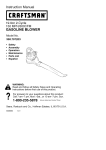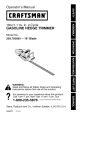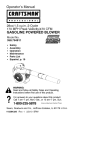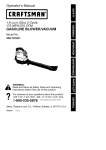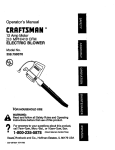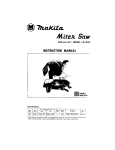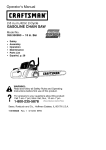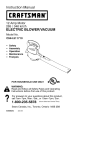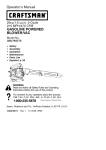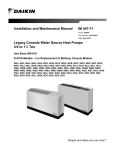Download Craftsman 358.797300 Instruction manual
Transcript
Instruction Manual I CRRFTSMRN°I 25cc/1.5 cu.in. 2-Cycle 185 MPH/385 CFM GASOLINE POWERED BLOWERNAC Model No. 358.797300 • Safety • Assembly • • Operation Maintenance • Parts • Espa_ol A 9 List WARNING: Read and follow all Safety Rules and Operating Instructions before first use of this product. For answers to your questions about this product: Call 7 am-7 pm, Mon.-Sat., or 10 am-7 pm, Sun. 1-800-235-5878 Sears, 530088072 Roebuck 10/1/01 and Co., Hoffman (Hours listed are Central Time) Estates, IL 60179 U.S.A. Warranty Statement Safety Rules Assembly Operation Maintenance Service & Adjustments 2 2 4 6 9 10 Storage Troubleshooting Table Emissions Statement Parts List Spanish Parts and Ordering 11 12 12 14 17 Back FULL TWO YEAR WARRANTY ON CRAFTSMAN ® GAS BLOWER For two (2) years from date of purchase, when this Gas Blower is maintained, lubricated, and tuned up according to the instructions in the instruction manual, Sears will repair, free of charge, any defects in material or workmanship. This warranty excludes blower tubes, spark plug, and air cleaner, which are expendable parts and become worn during normal use. If this blower is used for commercial purposes, this warranty applies for 90 days from the date of purchase. If this Blower is used for rental purposes, this warranty applies for 30 days from the date of purchase. This warranty applies only while this product is in use in the United States. WARRANTY SERVICE IS AVAILABLE BY RETURNING THE BLOWER TO THE NEAREST SEARS STORE OR SERVICE CENTER IN THE UNITED STATES. This warranty gives you specific legal rights, and you may also have other rights which vary from state to state. Sears, Roebuck and Co,, D/817WA, Hoffman Estates, IL 60179 _WARNING: Failure to follow all Safety Rules and Precautions can result in serious injury. KNOW YOUR UNIT • Read your instruction manual carefully until you completely understand and can follow all warnings and safety rules before operating the unit. • Restrict unit to users who understand and will follow all warnings and safety rules in this manual _LWARNING: Inspect area before starting unit. Remove all debris and hard objects such as rocks, glass, wire, etc. that can ricochet, be thrown, or otherwise cause injury or damage during operation. Use your unit as a blower for: • Sweeping debris or grass clippings from driveways, sidewalks, patios, etc. • Blowing grass clippings, straw, or leaves into piles, around joints, or between bricks. Use your unit as a vacuum for: • Picking up dry material such as leaves, grass, small twigs, and bits of paper. • For best results during vacuum use, operate your unit at high speed. • Move slowly back and forth over the material as you vacuum. Avoid forcing the unit into a pile of debris as this can clog the unit. • Keep the vacuum tube about an inch above the ground for best results. PLAN AHEAD • Always wear eye protection when operating, servicing, or performing maintenance on unit. Wearing eye protection will help to prevent rocks or debris from being blown or ricocheting into eyes and face which can result in blindness and/or serious injury. Eye protection should be marked Z87. • Always wear foot protection. Do not go barefoot or wear sandals. • Always wear respirator or face mask when working with unit in dusty environments. • Secure hair above shoulder length. Secure or remove jewelry, loose clothing, or clothing with loosely hanging straps, ties, tassels, etc. They can be caught in moving parts. • Donotoperate unitwhen youare picked upbytheairintake and tired,ill,upset, orifyouareunder the thrown outthrough discharge openinfluence ofalcohol, drugs, ormedi- ing,damaging unit,property, orcauscation. ingserious injury tobystanders or • Keep children, bystanders, andanioperator. malsaway fromworkareaamini• Avoid dangerous environments. Do notuseinunventilated areas or mumof30feet(10meters) when starting oroperating unit.Donot where explosive vapors orcarbon point blower nozzle inthedirection of monoxide buildupcouldbepresent. • Donotoverreach orusefromunstapeople orpets. blesurfaces suchasladders, trees, HANDLE FUEL WITH CAUTION, ITIS steep slopes, rooftops, etc.Keep firm HIGHLY FLAMMABLE footing andbalance atalltimes. • Eliminate allsources ofsparks or • Never place objects inside the flame (including smoking, open blower tubes; always direct theblowflames, orworkthatcancause ingdebris away frompeople, anisparks) intheareas where fuelis mals, glass, andsolidobjects such mixed, poured, orstored. automobiles, walls, etc.The • Mixandpour fuelinanoutdoor area; astrees, ofaircancause rocks, dirt,or store fuelinacool, dry,wellventilated force tobethrown ortoricochet place; useanapproved, marked con- sticks which canhurtpeople oranimals, tainer forallfuelpurposes. glass, orcause other damage. • Donotsmoke while handling fuelor • break Never rununitwithout theproper while operating theunit. equipment attached. When using • Make suretheunitisproperly asunitasablower, always install sembled andingoodoperating con- your blower tubes. When using theopdition. tional vacuum kit,always install vac• Donotfillfueltankwhileengine is uumtubes andvacuum bagassemrunning. surevacuum bagassem• Avoid spilling fueloroil.Wipe upfuel bly.Make blyiscompletely zipped. spillsbefore starting engine. • Check airintake opening, blower • Move atleast10feet(3meters) tubes, andvacuum tubes frequently, away fromfuelandfueling sitebealways withengine stopped and forestarting engine. plugdisconnected. Keep vents • Always storegasoline inacontainer spark anddischarge tubes freeofdebris approved forflammable liquids. which canaccumulate andrestrict OPERATE YOUR UNIT SAFELY proper airflow. Never place anyobject inairintake _kWARNING: Stoptheengine be- • opening asthis could r estrict proper air foreopening thevacuum inletdoor. andcause damage totheunit. Theengine must bestopped andthe • flow Never useforspreading chemicals, impeller blades nolonger turning to orothersubstances which avoid serious injury fromtherotating fertilizers, maycontain toxicmaterials. blades. • Toavoid spreading fire,donotuse • Inspect unitbefore eachusefor near leaf o rbrush fires, fireplaces, worn, loose, missing, ordamaged barbecue pits,ashtrays, etc. parts. Donotuseuntilunitisin • Useonlyforjobsexplained inthis proper working order. manual. • Keep outside surfaces freefromoil andfuel. MAINTAIN YOUR UNIT PROPERLY • Have allmaintenance other thanthe • Never startorrunengine inside a recommended procedures described closed room, building orother unventilated area.Breathing exhaust intheinstruction manual performed fumes cankill. bya Sears Service Center. • Toavoid static electricity shock, do • Disconnect spark plugbefore pernotwear rubber gloves oranyother forming maintenance except forcarinsulated gloves while operating unit. buretor adjustments. • Donotsetunitonanysurface ex• Useonlyrecommended CraftsmanZ ceptaclean, hard areawhileengine replacement parts; useofanyother isrunning. Debris suchasgravel, parts mayvoidyourwarranty and sand, dust, grass, etc.could be cause damage toyourunit. • Empty fueltankbefore storing the teetheavoidance ofthese problems. whooperate power toolsona unit.Useupfuelleftincarburetor by Users andregular basis must monistarting engine andletting itrununtil continual torclosely theirphysical condition and itstops. ofthistool. • Donotuseanyaccessory orattach- thecondition ment other thanthose recommendedSPECIAL NOTICE: Forusers onU.S. bymanufacturer forusewithyourunit. Forest Land andinsome states, includ• Donotstore theunitorfuelina ingCalifornia (Public Resources Codes closed areawhere fuelvapors can 4442 and4443), Idaho, Maine, Minnereach sparks oranopenflame from sota, NewJersey, Oregon, andWashhotwater heaters, electric motors or ington: Certain internal combustion enswitches, furnaces, etc. gines operated onforest, brush, and/or • Store inadryareaoutofreach of grass covered landintheabove areas children. arerequired tobeequipped withaspark screen, maintained ineffective SAFETY NOTICE: Exposure tovibra- arresting order, ortheengine must be tionsthrough prolonged useofgaso- working constructed, equipped, and maintained linepowered hand toolscould cause fortheprevention offire.Check with blood vessel ornerve damage inthe your state o rlocal authorities forregulafingers, hands, andjoints ofpeople tionspertaining tothese requirements. prone tocirculation disorders orabnor- Failure tofollow these requirements isa malswelling. Prolonged useincold violation ofthelaw. Thisunitisnotfactoweather hasbeenlinked toblood ves- ryequipped withaspark arresting seldamage inotherwise healthy screen; however, aspark arresting people. Ifsymptoms occur suchas screen isavailable asanoptional part. If numbness, pain, lossofstrength, aspark arresting screen isrequired in change inskincolor ortexture, orloss your area, contact Sears Service forthe offeeling inthefingers, hands, or correct kit.Thespark arresting screen, joints, discontinue theuseofthistool blower tubes, andnozzles must beasandseekmedical attention. An sembled tounittobeinfullcompliance antivibration system doesnotguaran- withregulations. CARTON CONTENTS Check carton contents against thefollowing list. Model 358.797300 • Blower • Blower tube • Elbow tube • Vacuum bag • Upper vacuum tube • Lower vacuum tube • 2-Cycle Engine Oil NOTE: It is normal for the fuel filter to rattle in the empty fuel tank. ASSEMBLY ,_WARNING: Stop engine and be sure the impeller blades have stopped turning before opening the vacuum inlet door or attempting to insert or remove the vacuum tubes. The rotating blades can cause serious injury. ,_ WARNING: unit assembled, If you receive your repeat all steps to en- sure your unit is properly assembled and all fasteners are secure. • A standard screwdriver is required for assembly. BLOWER ASSEMBLY BLOWER TUBE ASSEMBLY If you have already assembled your unit for use as a vacuum, remove the vacuum tubes and collection bag. 1. Align the rib on the blower tube with the groove in the blower outlet; slide the tube into place. NOTE: Tube clamp must be loose enough to allow blower tube to be inserted in blower outlet. Loosen tube clamp by turning knob counterclockwise. /'_'_. Blower _.,.€'_"_ Outlet Blower _'_. _. Groove 2. Tube ', Rib Tighten the tube clamp by turning the knob clockwise. 3. Toremove thetube, turntheknob toloosen clamp; remove tube. VACUUM ASSEMBLY VACUUM BAGASSEMBLY 1. Open thezipper onthevacuum bagandinsert theelbow tube. 2. Push thesmallendoftheelbow tubethrough thesmallopening in thebag. Elbow Tube Vacuum Tube Upper Lower Vacuum Tube 2. Latch Small Opening / 3. 4. _ _!_ _"] ..... Blower Latch Area Vacuum _, Outlet _._-_J7 - Inlet Cover Rib NOTE: Make sure edge of the small opening is flush against the flared area of the elbow tube, and the rib on the elbow tube is on the bottom. _ A_ 3. Zipper Opening Insert a screwdriver into the latch area on the vacuum inlet cover. 4. Gently tilt the handle of the screwdriver toward the back of the unit while pulling up on the vacuum inlet cover with your other hand. Hold the vacuum inlet cover open until upper vacuum tube is installed. Vacuum Inlet Close the zipper on the bag. Make sure the zipper is closed completely. Remove blower tube from engine. Retaining Pest Vln°, tm Cover 5. Place the hooks on the vacuum tube on the retaining posts; pivot tube into position. Secure vacuum tube by turning the knob clockwise until tight. _ Gro ve 5. Insert the elbow tube into the blower outlet. Make sure elbow tube is aligned with the blower outlet groove. 6. Turn clamp knob clockwise to tighten. VACUUM TUBE ASSEMBLY 1. Align the lower vacuum tube as shown. Push lower vacuum tube into upper vacuum tube. -- 6, _-- _oks When converting back to the blower feature, make sure latch on the vacuum inlet cover is securely fastened. SHOULDER STRAP ADJUSTMENT (for vacuum use only) 1. Hold the unit as shown. 2. Pass the shoulder strap over your head and onto your right shoulder. 3. Extend your left arm toward the rear of the vacuum bag. 4. Adjust shoulder strap until the vacuum bag/shoulder strap seam lies between your thumb and index finger. 5. Make sure air flows freely from the elbow tube into bag. If bag is kinked, the unit will not operate properly. KNOW YOUR BLOWER READ THIS INSTRUCTION MANUAL AND SAFETY RULES BEFORE OPERATING YOUR UNIT. Compare the illustrations with your unit to familiarize yourself with the location of the various controls and adjustments. Save this manual for future reference. Vacuum T Lower Vacuum Tube Upper _ Primer Button THROTTLE LEVER The THRO-i-rLE LEVER is used to select the desired engine speed and to stop the engine. Move the throttle lever to the position for full speed operation. Move the throttle lever to the _ position for idle speed. To stop the engine, move the throttle lever to the STOP position. the engine with fewer pulls on the starter rope. Activate primer button by pressing it and allowing it to return to its original position. CHOKE LEVER The CHOKE helps to supply fuel to the engine to aid in cold starting. Activate the choke by moving the choke lever to the FULL CHOKE position. After engine attempts to start, move the choke lever to the HALF CHOKE position. Once engine starts, move choke lever to the RUN position. PRIMER BUTTON The PRIMER BU-i-ION removes air _om the carburetor and fuel lines and fills them with fuel. This allows you to start -6- OPERATING TIPS • While vacuuming or blowing debris, hold the unit with the muffler side facing away from your body and clothes (see OPERATING POSITION). • To reduce the risk of hearing loss associated with sound level(s), hearing protection is required. • To reduce the risk of injury associated with contacting rotating parts, stop the engine before installing or removing attachments. Do not operate without guard(s) in place. • Operate power equipment only at reasonable hours-not early in the morning or late at night when people might be disturbed. Comply with times listed in local ordinances. Usual recommendations are 9:00 a.m. to 5:00 p.m., Monday though Saturday. • To reduce noise levels, limit the number of pieces of equipment used at any one time. • To reduce noise levels, operate power blowers at the lowest possible throttle speed to do the job. • Use rakes and brooms to loosen debris before blowing. • In dusty conditions, slightly dampen surfaces or use a mister attachment when water is available. • Conserve water by using power blowers instead of hoses for many lawn and garden applications, including areas such as gutters, screens, patios, grills, porches, and gardens. • Watch out for children, pets, open windows, or freshly washed cars. Blow debris away safely. • Use the full blower nozzle extension so the air stream can work close to the ground. • After using blowers and other equipment, CLEAN UP! Dispose of debris in trash receptacles. OPERATING POSITION Protection I Blower Vacuum BEFORE STARTING '_LWARNING: ENGINE Be sure to read the fuel information in the safety rules before you begin. If you do not understand the safety rules, do not attempt to fuel your unit. Call 1-800-235-5878. FUELING ENGINE ,_LWARNING: Remove fuel cap slowly when refueling. This engine is certified to operate on unleaded gasoline. Before operation, gasoline must be mixed with a good quality 2-cycle air-cooled engine oil. We recommend Craftsman brand oil. Mix gasoline and oil at a ratio of 40:1 (A 40:1 ratio is obtained by mixing 3.2 ounces of oil with 1 gallon of unleaded gasoline). DO NOT USE automotive oil or boat oil. These oils will cause engine damage. When mixing fuel, follow instructions printed on container. Once oil is added to gasoline, shake container momentarily to assure that the fuel is thoroughly mixed. Always read and follow the safety rules relating to fuel before fueling your unit. IMPORTANT Experience indicates that alcohol blended fuels (called gasohol or using ethanol or methanol) can attract moisture which leads to separation and formation of acids during storage. Acidic gas can damage the fuel system of an engine while in storage. To avoid engine problems, empty the fuel system before storage for 30 days or longer. Drain the gas tank, start the engine and let it run until the fuel lines and carburetor are empty. Use fresh fuel next season. Never use engine or carburetor cleaner products in the fuel tank or permanent damage may occur. Fuel stabilizer is an acceptable alternative in minimizing the formation of fuel gum deposits during storage. Craftsman brand oil is already blended with fuel stabilizer. See the STORAGE section for additional information. STOPPING YOUR ENGINE • To stop the engine, move the throttle lever to the STOP position. STARTING THEENGINE _LWARNING: You MUST make sure the tubes are secure before using the unit. • Fuel engine. Move at least 10 feet (3 meters) away from the fueling site. • Hold the unit in the starting position as shown. Make sure the blower end is directed away from people, animals, glass, and solid objects. .,_i@__p STARTING POSITION Blower Vacuum ,_ WARNING: When starting engine, hold the unit as illustrated. Do not set unit on any surface except a clean, hard area when starting engine or while engine is running. Debris such as gravel, sand, dust, grass, etc. could be picked up by the air intake and thrown out through the discharge opening, damaging the unit or property, or causing serious injury to bystanders or the operator. STARTING A COLD ENGINE (or a warm engine after running out of fuel) 1. Move the throttle lever to the position. 2. Move the choke lever to the FULL CHOKE position. 3. Slowly press the primer button 8 times. Throttle Lever Primer Button \4 Choke Lever 4, Pull starter handle sharply until the engine attempts to run, but no more than 5 pulls (below 30°F, 8 pulls). -8- NOTE: If the engine attempts to start before the 5th pull, go to the next step immediately. 5. Move choke lever to HALF CHOKE. 6. Pull the starter handle sharply until the engine runs, but no more than 5 pulls (below 30°F, 10 pulls). 7. After a 5 second warm-up, move the choke lever to the RUN position. 8. Allow the unit to run for 30 more seconds at RUN before moving the throttle lever to the _ position. If the engine has not started after 5 pulls (at HALF CHOKE), repeat the STARTING A COLD ENGINE procedure. If the engine still does not start, proceed to STARTING A FLOODED ENGINE. 9. To stop the engine, move the throttle lever to the STOP position. STARTING A WARM ENGINE 1. Move the throttle lever to the 4r_ position. 2. Pull the starter handle sharply until the engine starts, but no more than 5 pulls. NOTE: If the engine has not started, pull starter handle sharply for 5 more pulls. If engine still does not run, it is probably flooded. Proceed to STARTING A FLOODED ENGINE. 3. To stop the engine, move the throttle lever to the STOP position. STARTING A FLOODED ENGINE Flooded engines can be started by placing the choke lever in the RUN position. Move throttle lever to the fast position 4r_ ; then, pull rope until engine starts. After engine starts, move the throttle lever to the slow position -aF to allow engine to idle. Starting could require pulling the starter rope many times depending on how badly the unit is flooded. If the unit still doesn't start, refer to the TROUBLESHOOTING TABLE or call 1-800-235-5878. CUSTOMER RESPONSIBILITIES CARE & MAINTENANCE TASK WHEN TO PERFORM Check for loose fasteners and parts Before each use Check for damaged Before each use or worn parts Inspect and clean unit and labels Clean air filter After each use Replace spark plug Replace fuel filter Yearly Yearly Check muffler mounting Every 5 hours of operation screws Yearly WARNING: Avoid touching muffler unless engine and muffler are cold. A hot muffler can cause serious burns. ,_,WARNING: Stop engine and be sure the impeller blades have stopped turning before opening the vacuum inlet door or attempting to insert or remove the vacuum or blower tubes. The rotating blades can cause serious injury. Always disconnect the spark plug before performing maintenance or accessing movable parts. GENERAL RECOMMENDATIONS The warranty on this unit does not cover items that have been subjected to operator abuse or negligence. To receive full value from the warranty, the operator must maintain unit as instructed in this manual. Various adjustments will need to be made periodically to properly maintain your unit. CHECK FOR LOOSE FASTENERS AND PARTS • Spark Plug Boot • Air Filter • Housing Screws CHECK FOR DAMAGED OR WORN PARTS Contact Sears Service Center for replacement of damaged or worn parts. • Throttle Lever - Ensure throttle lever functions properly by moving the throttle lever to the STOP position. Make sure engine stops; then restart engine and continue. • Fuel Tank - Do not use unit if fuel tank shows signs of damage or leaks. • Vacuum Bag - Do not use vacuum bag if it is torn or damaged. -9- INSPECT AND CLEAN UNIT AND LABELS • After each use, inspect complete unit for loose or damaged parts. Clean the unit using a damp cloth with a mild detergent. • Wipe off unit with a clean dry cloth. CLEAN AIR FILTER __ Air Filter cover \ .JJ_F "_ J Screws / Air Filter A dirty air filter decreases engine performance and increases fuel consumption and harmful emissions. Always clean after every 5 hours of operation. Cleaning the air filter: 1. Clean the cover and the area around it to keep debris from falling into the carburetor chamber when the cover is removed. 2. Remove parts as illustrated. NOTE: Do not clean filter in gasoline or other flammable solvent. Doing so can create a fire hazard or produce harmful evaporative emissions. 3. Wash the filter in soap and water. 4. Allow filter to dry. 5. Apply a few drops of oil to the filter; squeeze filter to distribute oil. 6. Replace parts. REPLACE SPARK PLUG Replace spark plug each year to ensure the engine starts easier and runs better. Set spark plug gap at 0.025 inch. Ignition timing is fixed, nonadjustable. 1. Twist, then pull off spark plug boot. 2. Remove spark plug from cylinder and discard. 3. Replace with Champion CJ-6Y spark plug and tighten securely with a 3/4 in. socket wrench. 4. Reinstall the spark plug boot. REPLACE FUEL FILTER To replace fuel filter, drain unit by running it dry of fuel, then remove fuel cap/retainer assembly from tank. Pull filter from tank and remove it from the fuel line. Install new fuel filter on fuel line; reinstall parts. CHECK MUFFLER MOUNTING SCREWS Once each year, ensure muffler mounting screws are secure and tightened properly to prevent damage. Mounting _, Screw Muffler Cover _'_/_u*_\ H°les J'_ Screws 1. 2. 3. 4. Line ' I ___ Loosen and remove the 2 screws from the muffler cover. Remove the muffler cover. Tighten the 2 muffler mounting screws securely. Reinstall muffler cover and 2 screws. Tighten securely. Fuel Filter We recommend all service and adjustments not listed in this manual be performed by your Sears Service Center. CARBURETOR ADJUSTMENT Carburetor adjustment is critical and if done improperly can permanently damage the engine as well as the carburetor. If you require further assistance or are unsure about performing this procedure, call our customer assistance help line at 1-800-235-5878. Old fuel, a dirty air filter, a dirty fuel filter, or flooding may give the impression of an improperly adjusted carburetor. Check these conditions before adjusting the carburetor. The carburetor has been carefully set at the factory. Adjustments may be necessary if you notice any of the following conditions: • Engine will not idle. See LOW SPEED MIXTURE ADJUSTMENT (L) under adjusting procedure. • Engine dies or hesitates instead of accelerating. See ACCELERATION CHECK under adjusting procedure. -10- • Loss of power. See MIXTURE ADJUSTMENT (L or H) under adjusting procedure. There are two adjustment screws on the carburetor. The low speed adjustment screw is marked with the letter L, and the high speed adjustment screw is marked with the letter H. The throttle lever is used to control engine speed. The throttle lever can be placed in one offour positions: STOP, IDLE or -4111_ FULL THROTTLE or _, and one intermittent position. im er Button ever nt "H" Adjustment "L" ADJUSTING PROCEDURE CAUTION: Do not force plastic ]imiter caps on screws beyond the built-in stops or damage will occur. Initial Settings 1. Turn both mixture screws (L and H) counterclockwise until they stop. 2. Start engine, let it run for 3 minutes, then proceed to adjust screws according to the instructions below. If engine performance at initial settings is acceptable, no further adjustments are necessary. If engine does not start, refer to TROUBLESHOOTING TABLE. If still unable to remedy situation, call 1-800-235-5878. Low Speed Mixture Adjustment - L 1. Allow the engine to idle. 2. Turn low speed mixture screw (L) slowly clockwise until the speed begins to drop. 3. Turn the low speed mixture screw (L) counterclockwise until the speed ,_ WARNING: Perform the following steps after each use: • Allow engine to cool, and secure the unit before storing or transporting. • Store unit and fuel in a well ventilated area where fuel vapors cannot reach sparks or open flames from water heaters, electric motors or switches, furnaces, etc. • Store unit with all guards in place. Position unit so that any sharp object cannot accidentally cause injury. • Store unit and fuel well out of the reach of children. SEASONALSTORAGE Prepare unit for storage at end of season or if it will not be used for 30 days or more. If your unit is to be stored for a period of time: • Clean the entire unit before lengthy storage. • Store in a clean dry area. • Lightly oil external metal surfaces. FUEL SYSTEM Under FUELING ENGINE in the OPERATION section of this manual, see message labeled IMPORTANT regarding the use of gasohol in your engine. Fuel stabilizer is an acceptable alternative in minimizing the formation of fuel -11 increases and then starts to drop again. 4. Set the low speed mixture screw (L) at the midpoint between the two positions. High Speed Mixture Adjustment - H CAUTION: Adjust the mixture screw 1/16 of a turn at a time. A 1/16 turn is about the width of the slot in the top of the screw. 1. Run engine at full throttle. 2. Turn the high speed mixture screw (H) counterclockwise until it stops. 3. Turn the high speed mixture screw (H) 1/16 of a turn clockwise at a time until the engine runs smoothly.After completing adjustments, check for acceleration. Reset if necessary. Acceleration Check If engine dies or hesitates instead of accelerating, turn the low speed mixture screw (L) counterclockwise until you have smooth acceleration. gum deposits during storage. Add stabilizer to gasoline in fuel tank or fuel storage container. Follow the mix instructions found on stabilizer container. Run engine at least 5 minutes after adding stabilizer. Craftsman 40:1,2-cycle engine cooled) is already blended with stabilizer. If you do not use this oil, you can add a fuel stabilizer fuel tank. oil (air fuel Sears to your ENGINE • Remove spark plug and pour 1 teaspoon of 40:1,2-cycle engine oil (air cooled) through the spark plug opening. Slowly pull the starter rope 8 to 10 times to distribute oil. • Replace spark plug with new one of recommended type and heat range. • Clean air filter. • Check entire unit for loose screws, nuts, and bolts. Replace any damaged, broken, or worn parts. • At the beginning of the next season, use only fresh fuel having the proper gasoline to oil ratio. OTHER • Do not store gasoline from one season to another. • Replace your gasoline can if it starts to rust. - ,_OUBLESHOOTING TABLE WARNING: Always stop unit and disconnect spark plug before performing any of the recommended remedies below other than remedies that require operation of the unit. TROUBLE Engine will not start. CAUSE REMEDY 1. See "Starting a Flooded Engine" in Operation section. 2. Fill tank with correct fuel mixture. 1. Engine flooded. 2. Fuel tank empty. 3. Spark plug not firing. 4. Fuel not reaching carburetor. 5. Compression Engine will not idle properly. low. 1. Fuel not reaching carburetor. 2. Carburetor requires adjustment. 3. Crankshaft seals worn. 4. Compression Engine will not accelerate, lacks power, or dies under a load. low. 1. Air filter dirty. 2. Fuel not reaching carburetor. 1. Check for dirty fuel filter; replace. Check for kinked or split fuel line; repair or replace. 2. See "Carburetor Adjustment" in Service and Adjustments section. 3. Contact your Sears Service Center. 4. Contact your Sears Service Center. 1. Clean or replace air filter. 2. Check for dirty fuel filter; replace. Check for kinked or split fuel line; repair or replace. 3. Clean or replace spark plug and re-gap. 4. See "Carburetor Adjustment" in Service and Adjustments section. 5. Contact your Sears Service Center. 6. Contact your Sears Service Center. 3. Spark plug fouled. 4. Carburetor requires adjustment. 5. Carbon build up. 6. Compression low. Engine smokes excessively. 1. Choke partially on. 2. Fuel mixture incorrect. Engine 3. Air filter dirty. 4. Carburetor requires adjustment. 1. Fuel mixture incorrect. runs hot. 3. Install new spark plug. 4. Check for dirty fuel filter; replace. Check for kinked or split fuel line; repair or replace. 5. Contact your Sears Service Center. 2. Spark plug incorrect. 3. Carburetor requires adjustment. 4. Carbon build up. 1. Adjust choke. 2. Empty fuel tank and refill with correct fuel mixture. 3. Clean or replace air filter. 4. See "Carburetor Adjustment" in Service and Adjustments section. 1. See "Fueling section. Engine" in Operation 2. Replace with correct spark plug. 3. See "Carburetor Adjustment" in Service and Adjustments section. 4. Contact your Sears Service Center. YOUR WARRANTY RIGHTS AND OBLIGATIONS: The U. S. Environmental Protection Agency and Sears, Roebuck and Co., U.S.A., are pleased to explain the emissions control system warranty on your lawn and garden equipment engine. All new utility and lawn and garden equipment engines must be designed, built, and equipped to meet the stringent anti-smog standards. Sears must warrant the emission control system on your lawn and garden equipment engine for the periods of time listed below provided there has been no abuse, neglect, or improper maintenance of your lawn and garden equipment engine. Your emission control system includes parts such as the carburetor and the ignition system. Where a warrantable condition exits, Sears will repair your lawn and garden equipment engine at no cost to you. Expenses covered under warranty include diagnosis, parts and labor. -12- MANUFACTURER'S WARRANTY COVERAGE: If any emissions related part on your engine (as listed under Emissions Control Warranty Parts List) is defective or a defect in the materials or workmanship of the engine causes the failure of such an emission related part, the part will be repaired or replaced by Sears. OWNER'S WARRANTY RESPONSIBILITIES: As the lawn and garden equipment engine owner, you are responsible for the performance of the required maintenance listed in your instruction manual. Sears recommends that you retain all receipts covering maintenance on your lawn and garden equipment engine, but Sears cannot deny warranty solely for the lack of receipts or for your failure to ensure the performance of all scheduled maintenance. As the lawn and garden equipment engine owner, you should be aware that Sears may deny you warranty coverage if your lawn and garden equipment engine or a part of it has failed due to abuse, neglect, improper maintenance, unapproved modifications, or the use of parts not made or approved by the original equipment manufacturer. You are responsible for presenting your lawn and garden equipment engine to a Sears authorized repair center as soon as a problem exists. Warranty repairs should be completed in a reasonable amount of time, not to exceed 30 days. If you have any questions regarding your warranty rights and responsibilities, you should contact your nearest authorized service center or call Sears at 1-800-469-4663 WARRANTY COMMENCEMENT DATE: The warranty period begins on the date the lawn and garden equipment engine is purchased. LENGTH OF COVERAGE: This warranty shall be for a period of two years from the initial date of purchase. WHAT IS COVERED: REPAIR OR REPLACEMENT OF PARTS. Repair or replacement of any warranted part will be performed at no charge to the owner at an approved Sears servicing center. If you have any questions regarding your warranty rights and responsibilities, you should contact your nearest authorized ser- -13- vice center or call Sears at 1-800-469-4663. WARRANTY PERIOD: Any warranted part which is not scheduled for replacement as required maintenance, or which is scheduled only for regular inspection to the effect of "repair or replace as necessary" shall be warranted for 2 years. Any warranted part which is scheduled for replacement as required maintenance shall be warranted for the period of time up to the first scheduled replacement point for that part. DIAGNOSIS: The owner shall not be charged for diagnostic labor which leads to the determination that a warranted part is defective if the diagnostic work is performed at an approved Sears servicing center. CONSEQUENTIAL DAMAGES: Sears may be liable for damages to other engine components caused by the failure of a warranted part still under warranty. WHAT IS NOT COVERED: All failures caused by abuse, neglect, or improper maintenance are not covered. ADD-ON OR MODIFIED PARTS: The use of add-on or modified parts can be grounds for disallowing a warranty claim. Sears is not liable to cover failures of warranted parts caused by the use of add-on or modified parts. HOW TO FILE A CLAIM: If you have any questions regarding your warranty rights and responsibilities, you should contact your nearest authorized service center or call Sears at 1-800-469-4663. WHERE TO GET WARRANTY SERVICE: Warranty services or repairs shall be provided at all Sears service centers, call: 1-800-469-4663. MAINTENANCE, REPLACEMENT AND REPAIR OF EMISSION RELATED PARTS: Any Sears approved replacement part used in the performance of any warranty maintenance or repair on emission related parts will be provided without charge to the owner if the part is under warranty. EMISSION CONTROL WARRANTY PARTS LIST: Carburetor, Ignition System: Spark Plug (covered up to maintenance schedule), Ignition Module. MAINTENANCE STATEMENT: The owner is responsible for the performance of all required maintenance as defined in the instruction manual.













